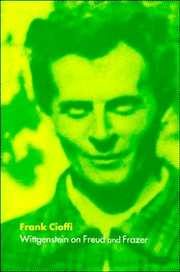Book contents
- Frontmatter
- Contents
- Acknowledgements
- Introduction: Wittgenstein on explanation and self-clarification
- 1 Information, contemplation and social life
- 2 Aesthetic explanation and aesthetic perplexity
- 3 Wittgenstein and the Fire-festivals
- 4 When do empirical methods by-pass ‘the problems which trouble us’?
- 5 Explanation, self-clarification and solace
- 6 Wittgenstein on making homeopathic magic clear
- 7 Wittgenstein and obscurantism
- 8 Wittgenstein on Freud's ‘abominable mess’
- 9 Congenital transcendentalism and ‘the loneliness which is the truth about things’
- AFTERWORD
- 10 Explanation and self-clarification in Frazer
- 11 Explanation and self-clarification in Freud
- 12 Conclusion: two cheers for the coroner's report
- Index
11 - Explanation and self-clarification in Freud
Published online by Cambridge University Press: 05 January 2010
- Frontmatter
- Contents
- Acknowledgements
- Introduction: Wittgenstein on explanation and self-clarification
- 1 Information, contemplation and social life
- 2 Aesthetic explanation and aesthetic perplexity
- 3 Wittgenstein and the Fire-festivals
- 4 When do empirical methods by-pass ‘the problems which trouble us’?
- 5 Explanation, self-clarification and solace
- 6 Wittgenstein on making homeopathic magic clear
- 7 Wittgenstein and obscurantism
- 8 Wittgenstein on Freud's ‘abominable mess’
- 9 Congenital transcendentalism and ‘the loneliness which is the truth about things’
- AFTERWORD
- 10 Explanation and self-clarification in Frazer
- 11 Explanation and self-clarification in Freud
- 12 Conclusion: two cheers for the coroner's report
- Index
Summary
HYPOTHESES AND FURTHER DESCRIPTIONS
The instruments of self-clarification are ‘further descriptions’. Wittgenstein's examples are varied but the contrast with that which we can only know through investigation is maintained. All these are dubbed hypotheses. The notion of identifying, elaborating, correcting, refining on an earlier mindstate is familiar. William James has several felicitous evocations of the incitements to this activity. He speaks of‘ … relations and objects but dimly perceived’ of the ‘halo or penumbra that surrounds’ an image; of ‘being aware in a penumbral nascent way of a fringe of unarticulated affinities’; of ‘Vast premonitory glimpses of schemes of relations between terms’ of a ‘halo of felt relations’; of ‘the vague sense of a plus ultra’ etc. (William James, The Principles of Psychology, New York: Dover, 1950, 254–9).
A psychotherapist calls the statements in which we attempt to articulate the ‘unarticulated affinities’, of which James speaks, ‘focusing utterances’, ‘the putting into unambiguous words of something (which) is just outside the ‘focus range’ of consciousness'. He illustrates: ‘let us suppose that a disinterested friend say to a man who has for a long time been suffering from a vague malaise,
If you were honest with yourself you would admit that you are bored with your job and unhappy with your wife and that you stick in the rut out of habit and fear of change. This remark comes at a time when it is sufficient to make his dissatisfaction specific and fully conscious. In one sense of ‘know’ he had known for a long time what his friend had put into words.
- Type
- Chapter
- Information
- Wittgenstein on Freud and Frazer , pp. 264 - 300Publisher: Cambridge University PressPrint publication year: 1998



